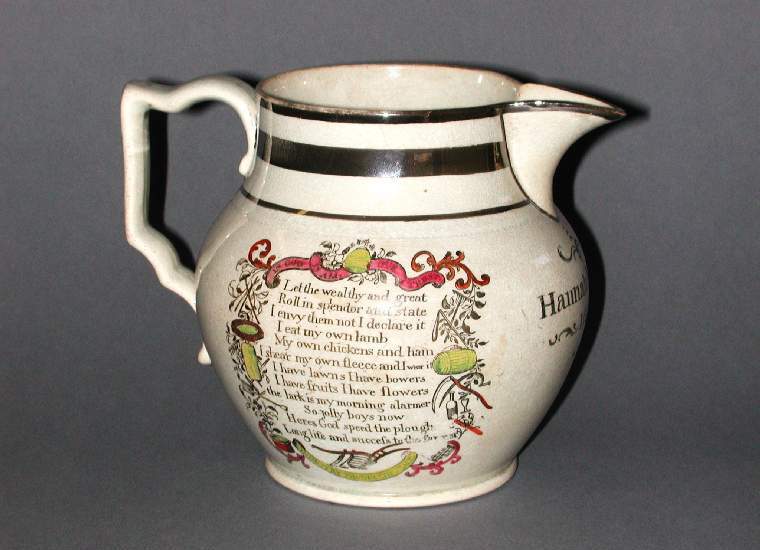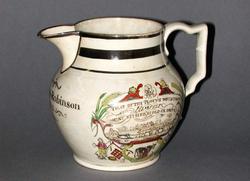Current Location: In storage
Titles
Hannah Robinson jug
Maker(s)
Factory:
Unidentified Staffordshire Pottery
(Probably)
Entities
Categories
Description
White earthenware, transfer-printed over-glaze in brown with text and images, and painted with green, yellow, purple and orange-red enamels and silver (platinum) lustre.
Ovoid body tapering slightly to a projecting foot, with a concave cylindrical neck, curved lip and curving, angular handle. Inscription under the lip, ‘Hannah Robinson / 1812’, with scroll decorative motifs, painted in dark brown. Text and image transfer-prints, over-painted with enamels, on each side of the body. A thin band of silver lustre around the rim of the jug, another where the neck meets the body and a thicker band around the middle of the neck. The underside is flat and glazed, with a raised foot-rim.
The images and texts are as follows:
(a) a scene of a plough pulled by three horses in front of farm buildings and trees. Above are a barrel and an ear of barley to the left and a beehive and an ear of wheat to the right. Below are a man with a flail, a jug and a dog; a maid milking a cow; and a woman with a sickle, a sheaf of wheat and a dog. In the centre of the image is the inscription ‘HE / THAT BY THE PLOUGH WOULD THRIVE / HIMSELF / MUST EITHER HOLD OR DRIVE’. Below, on a u-shaped ribbon, is the motto ‘INDUSTRY PRODUCETH WEALTH’.
(b) a verse: ‘Let the wealthy and great / Roll in splendour and state / I envy them not I declare it / I eat my own lamb / My own chickens and ham / I shear my own fleece and I ware it / I have lawns I have bowers / I have fruits I have flowers / the lark is my morning alarmer / So jolly boys now / Heres God speed the plough / Long life and success to the farmer’ bordered by plants and agricultural and domestic objects. Above the verse is the inscription ‘IN GOD IS ALL OUR TRUST’ on a ribbon with a beehive and below is the motto ‘INDUSTRY PRODUCETH WEALTH’ on a ribbon with a plough.
Notes
History note: Bought from Mrs Mary Carey, Judd Street, London, N, for 25 shillings, on 15 May 1909 by Dr J.W.L. Glaisher, FRS, Trinity College, Cambridge. According to Mrs Carey, bought from Hannah Robinson’s granddaughter, Elizabeth Parrish.
Legal notes
Dr J.W.L. Glaisher Bequest.
Measurements and weight
Height: 14.5 cm
Width: 17 cm
Acquisition and important dates
Method of acquisition: Bequeathed
(1928-12-07)
by
Glaisher, J. W. L., Dr
Dating
19th Century, Early
George III
Production date:
AD 1812
Note
Label text from the exhibition ‘Feast and Fast: The Art of Food in Europe, 1500–1800’, on display at The Fitzwilliam Museum from 26 November 2019 until 31 August 2020:This small, highly decorated jug, likely for milk or ale, is inscribed ‘Hannah Robinson 1812’. When Dr Glaisher purchased it in 1909, he was told that Hannah had been given this jug when she married Gabriel Store, in 1812, probably at Burslem, Staffordshire. The imagery celebrates the production of grain, with verses from a traditional English ballad sung on Plough Monday, when farm labourers returned to work after Christmas and started ploughing. Although the song celebrates self-sufficiency, the jug is a promotion of work, with the motto ‘INDUSTRY PRODUCETH WEALTH’ reproduced twice.
On purchasing this jug in 1909, Dr Glaisher was told that Hannah Robinson was given this jug on the occasion of her marriage to Gabriel Store, in 1812, probably at Burslem. He was also told that both Hannah and Gabriel came from Staffordshire families associated with the pottery business, though the decorative theme on this jug is clearly agriculture. Staffordshire was the first, and remained the largest, producer of lustreware, though it was also made in other regions, notably Sunderland. Silver lustre is generally made from platinum, as real silver suffers from tarnishing.
The verse ‘Let the wealthy and great…’ is common on jugs celebrating agriculture. It is drawn from a traditional English song based on the 15th century ballads sung by ploughmen on Plough Monday, the first Monday following the Twelfth Day of Christmas, when farm labourers returned to work. The inscription on the other side of the jug – ‘He that by the plough would thrive, himself must either hold or drive’ – is a traditional proverb
Transfer printing was introduced to English pottery in the second half of the 18th century. Most early transfer-printed ware used the glue bat method. In this method, the design was engraved on a copper plate, which was then covered with linseed oil. The thin bat of animal glue was pressed onto the oiled plate and then applied to the ware. Once the bat was removed, the ware was dusted with powdered metallic oxide, which adhered to the oil, and fired to fix the design. This method was common for round-bodied vessels because the flexible glue bat can easily stretch round curving body.
People, subjects and objects depicted
Components of the work
Body
Materials used in production
brownish-black
Ceramic printing colour
clear with slightly bluish cast
Lead-glaze
platinum
Lustre
white
Earthenware
Enamels
Techniques used in production
Lead-glazing
Transfer printing
Painting overglaze
Lustring
Inscription or legends present
- Text: Hannah Robinson 1812
- Location: Front of jug, on body below lip
- Method of creation: Painted onglaze in black enamel
- Type: Inscription
- Text: HE / THAT BY THE PLOUGH WOULD THRIVE / HIMSELF / MUST EITHER HOLD OR DRIVE
- Location: Above the ploughing scene on side of jug
- Method of creation: Transfer-printed onglaze in brownish-black
- Type: Inscription
- Text: INDUSTRY PRODUCETH WEALTH
- Location: Below the ploughing scene on side of jug
- Method of creation: Transfer-printed onglaze in brownish-black
- Type: Inscription
- Text: Let the wealthy and great / Roll in splendour and state / I envy them not I declare it / I eat my own lamb / My own chickens and ham / I shear my own fleece and I ware it / I have lawns I have bowers / I have fruits I have flowers / the lark is my morning alarmer / So jolly boys now / Heres God speed the plough / Long life and success to the farmer
- Location: On side of jug
- Method of creation: Transfer-printed onglaze in brownish-black
- Type: Inscription
- Text: IN GOD IS ALL OUR TRUST
- Location: Above the verse on side of jug
- Method of creation: Transfer-printed onglaze in brownish-black
- Type: Inscription
- Text: INDUSTRY PRODUCETH WEALTH
- Location: Below the verse on side of jug
- Method of creation: Transfer-printed onglaze in brownish-black
- Type: Inscription
Inscription present: rectangular, stick-on white paper label with blue border
- Text: No2989 Staffordshire jug inscribed ‘Hannah Robinson 1812’ and with verses &c. in coloured borders, b. in London May 15, 1909
- Location: On base
- Method of creation: Rectangular paper label handwritten in black ink
- Type: Label
References and bibliographic entries
Related exhibitions
Identification numbers
Accession number: C.774-1928
Primary reference Number: 76036
Old catalogue number: 2989
Stable URI
Audit data
Created: Saturday 6 August 2011
Updated: Friday 1 August 2025
Last processed: Friday 1 August 2025
Associated departments & institutions
Owner or interested party:
The Fitzwilliam Museum
Associated department:
Applied Arts





